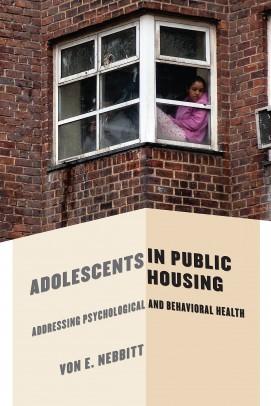Book looks at black youth in public housing environment

A new book hopes to bring to light the mental health status and health-risk behaviors of African American youth living in public housing.
In the first published volume on black youth living in public housing based on data collected in many housing developments in several large U.S. cities, a University of Illinois at Chicago professor examines how life in public housing affects adolescent mental health symptoms and health-risk behaviors.
“Adolescents in Public Housing: Addressing Psychological and Behavioral Health” (Columbia University Press, 2015) provides a grasp of the deviance, substance abuse, and depressive symptoms that characterize these communities — and links them to gaps in policy and practice.
The book should be “an important contribution to our collective understanding of the capacities, strengths and challenges of an understudied and vulnerable population of American youth,” says its author, Von Nebbitt, associate professor in UIC’s Jane Addams College of Social Work.
Nebbitt’s motivation for writing the book came from his frustration — over the span of his academic career — in searching for broad-based empirical studies or theoretical frameworks concerning minority youth in public housing.
“As a doctoral student, I was surprised to discover that research on minority youth living in public housing was a patchwork of single-site or single-city studies, which offered very little in the way of a unique theory to explain life in public neighborhoods,” Nebbitt said. His book “represents an important step” toward providing that missing picture, he said.
The book also addresses the mental health status and health-risk behaviors of black youth in public housing that Nebbitt says were unaffected by a 1990s housing strategy called Housing Opportunities for People Everywhere, or HOPE VI. The $5 billion federal strategy to transform distressed public housing launched in many large U.S. cities but had limited effect, he said.
Nebbitt believes that since HOPE VI wrapped up, policymakers and practitioners may think the public housing challenge has mostly been met, and the problems of the millions of youth still living in traditional public housing may go unnoticed or unaddressed.
The first of the book’s three sections provides a background and theoretical discussion on youth development within public neighborhoods. The second section examines cross-sectional data of 900 black youth in public housing in New York City, Philadelphia, Washington, and St. Louis from 2005 to 2008. The third section is recommendations for policy and practice.
The study used an integrated, community-based research design. Using a battery of standardized survey instruments, Nebbitt measured both positive and negative aspects of the public housing environment, including parents’ behaviors and family life and peers’ behaviors and relationships, all with the goal of assessing their respective impact on vulnerable adolescents’ mental health and health-risk behaviors.
“The central role that community cohesion plays in the well-being of adolescents in public housing is a key finding in this book,” Nebbitt said “With this information in hand, local housing authorities should create more opportunities for the general public to become involved in the issues that affect them. Practitioners should work with youth groups, encouraging and preparing them to work together to make a difference in their communities.”
Findings also challenge long-held assumptions that all public housing projects are nothing but “constellations of crime, gangs and drugs,” Nebbitt said — assumptions that have led to stigmas and stereotypes of public housing and its young residents. A view of public housing as an environment that only nurtures antisocial or criminal behavior doesn’t take into account the many positive social influences and opportunities that may exist in these communities.
“Although there are numerous potential negative influences in public housing communities,” Nebbitt writes, “the research in this book purports that these negative influences can be counterbalanced by positive influences.”
Categories
Topics
adolescent, African American, African American health, black, College of Social Work, mental health, public housing, youth
